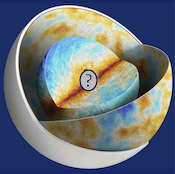I will present single frequency morphological foreground removal and denoising using deep learning (in a Bayesian likelihood-free framework) using phase harmonic augmentation. With only a single training image of polarized dust foregrounds, we are able to generate new realisations using wavelet phase harmonic synthesis. In a likelihood-free inference framework, these new realisations can be...
Precise measurements of cosmological parameters have revealed tensions in the standard model of cosmology. One way of studying these tensions is to check the robustness of our datasets using observables that are less sensitive to systematic effects. In this talk I will discuss the properties of the Pearson's correlation coefficient of T and E modes $\mathcal{R}_\ell^{TE}$; a combination of the...
In the quest for the Cosmic Microwave Background (CMB) primordial $B$-modes, being able to accurately characterise the polarised foregrounds will be decisive. The mismodeling of their complex spectral properties could lead to a bias on the final estimation of the tensor-to-scalar ratio $r$. Finding a method to avoid this issue is central for future key surveys like the LiteBIRD satellite,...
CMB data is a crucial source of information about reionisation. Despite the exquisite measurements of Planck on large scales and SPT, ACT or future CMB-S4 experiments on small scales, the way CMB data is currently used to constrain reionisation is coarse.
In this talk, we focus on the kinetic Sunyaev-Zel’dovich effect in the context of patchy reionisation and introduce a new way to relate...
The kinetic Sunyaev-Zel'dovich (kSZ) effect is caused by the scattering of CMB photons off the electrons due to the object's bulk motion. It is proportional to the peculiar velocity but also depends on the properties of the virialized gas as well as the gas surrounding halos.
I will present the statistical detection of the kSZ effect from ~30,000 galaxy clusters identified in the SDSS...

